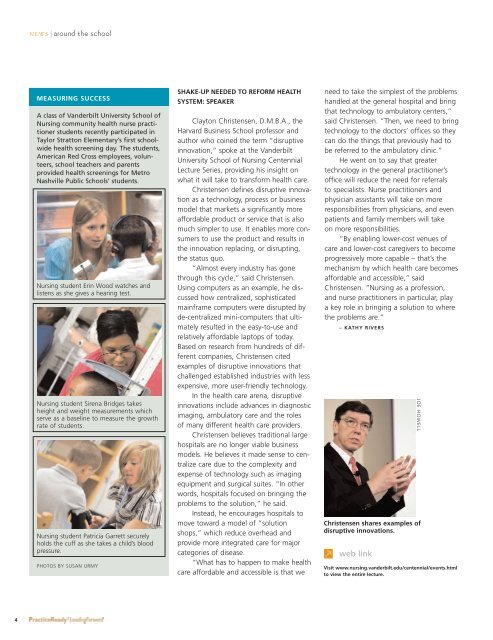Removing the Dark Clouds - Vanderbilt University School of Nursing
Removing the Dark Clouds - Vanderbilt University School of Nursing
Removing the Dark Clouds - Vanderbilt University School of Nursing
Create successful ePaper yourself
Turn your PDF publications into a flip-book with our unique Google optimized e-Paper software.
4<br />
N E W S |around <strong>the</strong> school<br />
MEASURING SUCCESS<br />
A class <strong>of</strong> <strong>Vanderbilt</strong> <strong>University</strong> <strong>School</strong> <strong>of</strong><br />
<strong>Nursing</strong> community health nurse practitioner<br />
students recently participated in<br />
Taylor Stratton Elementary’s first schoolwide<br />
health screening day. The students,<br />
American Red Cross employees, volunteers,<br />
school teachers and parents<br />
provided health screenings for Metro<br />
Nashville Public <strong>School</strong>s’ students.<br />
<strong>Nursing</strong> student Erin Wood watches and<br />
listens as she gives a hearing test.<br />
<strong>Nursing</strong> student Sirena Bridges takes<br />
height and weight measurements which<br />
serve as a baseline to measure <strong>the</strong> growth<br />
rate <strong>of</strong> students.<br />
<strong>Nursing</strong> student Patricia Garrett securely<br />
holds <strong>the</strong> cuff as she takes a child’s blood<br />
pressure.<br />
PHOTOS BY SUSAN URMY<br />
SHAKE-UP NEEDED TO REFORM HEALTH<br />
SYSTEM: SPEAKER<br />
Clayton Christensen, D.M.B.A., <strong>the</strong><br />
Harvard Business <strong>School</strong> pr<strong>of</strong>essor and<br />
author who coined <strong>the</strong> term “disruptive<br />
innovation,” spoke at <strong>the</strong> <strong>Vanderbilt</strong><br />
<strong>University</strong> <strong>School</strong> <strong>of</strong> <strong>Nursing</strong> Centennial<br />
Lecture Series, providing his insight on<br />
what it will take to transform health care.<br />
Christensen defines disruptive innovation<br />
as a technology, process or business<br />
model that markets a significantly more<br />
affordable product or service that is also<br />
much simpler to use. It enables more consumers<br />
to use <strong>the</strong> product and results in<br />
<strong>the</strong> innovation replacing, or disrupting,<br />
<strong>the</strong> status quo.<br />
“Almost every industry has gone<br />
through this cycle,” said Christensen.<br />
Using computers as an example, he discussed<br />
how centralized, sophisticated<br />
mainframe computers were disrupted by<br />
de-centralized mini-computers that ultimately<br />
resulted in <strong>the</strong> easy-to-use and<br />
relatively affordable laptops <strong>of</strong> today.<br />
Based on research from hundreds <strong>of</strong> different<br />
companies, Christensen cited<br />
examples <strong>of</strong> disruptive innovations that<br />
challenged established industries with less<br />
expensive, more user-friendly technology.<br />
In <strong>the</strong> health care arena, disruptive<br />
innovations include advances in diagnostic<br />
imaging, ambulatory care and <strong>the</strong> roles<br />
<strong>of</strong> many different health care providers.<br />
Christensen believes traditional large<br />
hospitals are no longer viable business<br />
models. He believes it made sense to centralize<br />
care due to <strong>the</strong> complexity and<br />
expense <strong>of</strong> technology such as imaging<br />
equipment and surgical suites. “In o<strong>the</strong>r<br />
words, hospitals focused on bringing <strong>the</strong><br />
problems to <strong>the</strong> solution,” he said.<br />
Instead, he encourages hospitals to<br />
move toward a model <strong>of</strong> “solution<br />
shops,” which reduce overhead and<br />
provide more integrated care for major<br />
categories <strong>of</strong> disease.<br />
“What has to happen to make health<br />
care affordable and accessible is that we<br />
need to take <strong>the</strong> simplest <strong>of</strong> <strong>the</strong> problems<br />
handled at <strong>the</strong> general hospital and bring<br />
that technology to ambulatory centers,”<br />
said Christensen. “Then, we need to bring<br />
technology to <strong>the</strong> doctors’ <strong>of</strong>fices so <strong>the</strong>y<br />
can do <strong>the</strong> things that previously had to<br />
be referred to <strong>the</strong> ambulatory clinic.”<br />
He went on to say that greater<br />
technology in <strong>the</strong> general practitioner’s<br />
<strong>of</strong>fice will reduce <strong>the</strong> need for referrals<br />
to specialists. Nurse practitioners and<br />
physician assistants will take on more<br />
responsibilities from physicians, and even<br />
patients and family members will take<br />
on more responsibilities.<br />
“By enabling lower-cost venues <strong>of</strong><br />
care and lower-cost caregivers to become<br />
progressively more capable – that’s <strong>the</strong><br />
mechanism by which health care becomes<br />
affordable and accessible,” said<br />
Christensen. “<strong>Nursing</strong> as a pr<strong>of</strong>ession,<br />
and nurse practitioners in particular, play<br />
a key role in bringing a solution to where<br />
<strong>the</strong> problems are.”<br />
– KATHY RIVERS<br />
Christensen shares examples <strong>of</strong><br />
disruptive innovations.<br />
web link<br />
JOE HOWELL<br />
Visit www.nursing.vanderbilt.edu/centennial/events.html<br />
to view <strong>the</strong> entire lecture.


